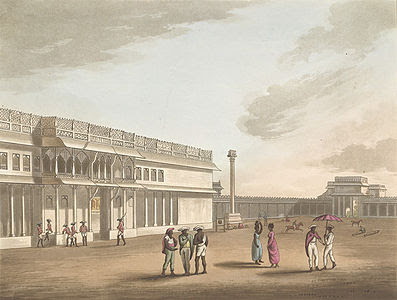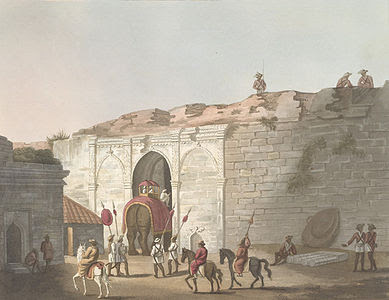 |
| Lt. James Hunter military artist Alamy |
 |
| Lt. James Hunter artist .Tippoo's palace, Bangalore. Wikiwand |
 |
| Tipu Sultans sons and mother. rarebooksocietyofindia.org/ |
 |
James Hunter. c.1740-1792.
|
Picturesque Scenery in the Kingdom of Mysore. London: Edward Orme, [1804]-1805.
James Hunter was a Lieutenant in the Royal Artillery under Cornwallis during the Third Anglo-Mysore War where British and Company troops defeated the Tipu Sultan. The views here include landmarks in Seringapatam, Bangalore, the surrounding countryside, as well as British encampments. Source: Bonhams ....................................
James Hunter was was a military officer in India under the East India company and was an artist of repute. His subjects of painting and art work were related to military village scenes in India. His drawings on Mysore kingdom and the Mysore-Angelo war were internationally famous.
A group of volunteers in 1791 was chose, well trained and raised from the Royal Artillery battalions in England and their mission was to serve in British India. This led to the creation of two companies with a major, adjutant and quarter-master, along with the men. They were part of East India company's large military force (under the proxy of the British government). At this point of time the British were on a land-grabbing spree and having successfully seized many kingdoms in the north, they had just come to the south to try their luck. That time their formidable enemy was Tipu Sultan, a shrewd and intelligent warrior, a gritty man not to be cowed down that easily.
These two companies served effectively under Lord Cornwallis in the Tipu Sultan campaigns, leading to the defeat and siege of Tipu's army at Srirangapatna in 1792. Major Scott, was killed on 9 February 1792 in action, during the campaign. With a peace treaty having been signed with Tipu Sultan, Lt. James Hunter, with the assistance of Lt C. Gold made sketches of life in India and objects and buildings that drew their attention. These sketches were published by C Gold with the title Oriental Drawings and attracted much attention in England as they were considered as valuable addition to British understanding of Indian culture. Lt. Hunter died in India in May 18 1791.
James Hunter soon became a Lieutenant in the Royal Artillery under the command of Marquess Cornwallis (31 December 1738 – 5 October 1805). Also known as Viscount Brome (1753 and 1762) and as The Earl Cornwallis between 1762 and 1792, earlier he was a British Army officer and colonial administrator. In the United States and the United Kingdom. He fought against the Americans in the American War of Independence and his famous surrender in 1781 to a combined American and French force at the Siege of Yorktown put an end to the significant hostilities in North America
As a military artist, Hunter was good at painting and doing sketches on subjects related to military matters and every day affairs. His active participation in the military war campaign against Tipu Sultan of Mysore, the ruler who gave nightmares to the British high commands with his Mysorian rockets and unpredictable strategy, gave him ample opportunities to draw sketches of Srirangapatna. The other places included were Mysore, Bangalore Madras, etc.
Hunter has sketched different landscapes of South India, including Hosur, Kancheepuram, Madras, Arcot, Sriperumbudur, etc. These paintings were
Hunter died at a young age of 36 in Vellore, Madras Presidency in India. A monument was erected by his affectionate brother Arthur Hunter who recorded his birthday as 15 November 1755 and death on 19 May 1792. He was buried in the old cemetery in Commissary Bazaar, Vellore in Vellore district, Tamil Nadu.
The credit goes to Joseph C Stadler, J B Harraden and H Merke, who, after Hunter's death in 1792, took so efforts to save the painstaking works of Hunter. They took up the work of 'aquatint etching' of the paintings on copper plates. Edward Orme in 1804 published in London the fourty of Hunter's beautiful works under the title Picturesque scenery in the Kingdom of Mysore. In comparison to the work of Robert Home, Lt. R H Colebroke Capt. Allan, Hunter’s work are associated often with Tipu Sultan and his father Hyder Ali and depicts the military and civil life of Bangalore in the late 18th century
 |
The Square & Entrance Into Tippoo's Palace, Bangalore, James Hunter (d.1792) |
 |
| The Delhi Gate Bangalore by James Hunter (d.1792) wikipedia. |
 |
| Royal Artillery Encampment at Arcot – James Hunter (Public Domain) |
 |
| http://bengaluru-heritage.mapunity.com |
| Above image: Mysore gate Bangalore fort. |
 |
| Krishnagiri hill by James Hunter. en.wikipedia.org/ |
Above image" East View Of Kistnaghurry (Krishnagiri by James Hunter t: East View Of Kistnaghurry (Krishnagiri by James Hunter.
 |
Gopaldrug, Mysore. .rarebooksocietyofindia.org |
Above image: View of Gopaul Droog, Mysore - James Hunter. Original watercolour. Source: Bonhams
Tit-Bits:
 |
| Cornwallis receiving Tipu's sons.rarebooksocietyofindia.org |
Oil on metal fixed on panel, 44.5 x 52 cm. This two-part oil sketch is related to a series of three paintings Mather Brown produced to commemorate the military defeat of Tipu, the Sultan of Mysore, by Lord Cornwallis, the British military commander-in-chief, which ended the Third Anglo-Mysore War. Lord Cornwallis had defeated Tipu in May 1791 but the Peace Treaty was not signed until March 1792, at which time two of Tipu's sons were taken as temporary hostages by the British to ensure compliance with the treaty. Mather Brown didn' t leave England to record these dramatic events, but based his work on descriptive military reports and his own speculation. Collection: The Bowes Museumhttp://www.rarebooksocietyofindia.org/postDetail.php?id=196174216674_10152504141991675
https://en.wikipedia.org/wiki/James_Hunter_(military_artist)
http://bengaluru-heritage.mapunity.com






.jpg)

.jpeg)
